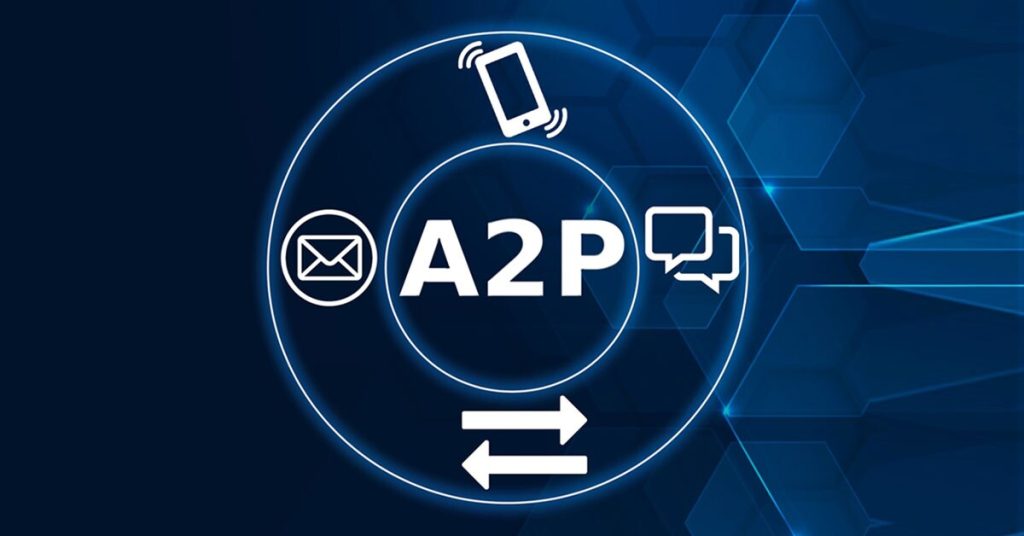
SMS aggregators play a critical role in the Application-to-Person (A2P) messaging ecosystem, enabling businesses to send automated messages to customers through secure and efficient routes. By acting as intermediaries between enterprises and mobile network operators, aggregators ensure high message deliverability, regulatory compliance, and cost optimization.
This blog will be a deep dive into the A2P messaging landscape. We will explore the role of SMS Aggregators in delivering A2P messaging services to businesses, along with examples based on real scenarios and the associated security aspects.
Understanding A2P Messaging

A2P or Application-to-Person messaging refers to SMS sent from an enterprise application to a customer’s mobile phone, rather than messages exchanged between individuals, which is P2P messaging. These messages are automated, triggered by business workflows, and delivered via high-speed, secure messaging routes.
To put it more formally, A2P messaging refers to the automated SMS messages sent from a business application to any person/ individual, often for marketing, transactional, and informational purposes.
For a more clear understanding of A2P messaging, let’s compare it with its counterpart, i.e. P2P messaging, or Person-to-Person messaging, in more depth.
Before we move towards the differences between these two messaging systems, let’s first explore the similarities they share.
Both A2P and P2P use SMS, RCS and messaging apps to deliver information. For example, a financial institution such as a bank sends a “Your OTP for net banking login is 2356” message to a customer, which is A2P. While a person sends a text “Hey, What time will you be free?” message to a friend, which is P2P.
Another similarity shared by A2P and P2P is that both connect users via telecom networks or internet-based platforms. For example, an ecommerce company sends a promotional offer via SMS using a telecom operator, which is A2P. Also, a person texts a friend via SMS when they are not connected to the internet, which is P2P.
It is clear that A2P and P2P share similarities in terms of communication channels and infrastructure used, the core difference between the two lies in the intent for which they are used. A2P is used by businesses for automation and bulk messaging, and P2P is used for personal conversation between individuals.
The table below clearly highlights the key differences between A2P and P2P messaging.
|
Aspect |
A2P | P2P |
|
Definition |
Automated messages from applications to individuals |
Messages exchanged between individuals |
|
Use Cases |
Transactional alerts, promotional, and customer support |
Personal conversations |
| Sender Type |
Businesses/ Companies |
Individuals |
| Regulation | Requires consent and compliance |
Less regulated |
Can A2P Messaging Be Two-Way?
Traditionally, A2P messaging has been a one-way communication tool wherein a business/ application sends messages to customers without expecting a reply or response. However, as the messaging technology advanced, two-way A2P messaging became a reality, helping businesses to create interactive experiences.
How Does 2-Way A2P Messaging Work?
In the two-way A2P messaging system, the recipients respond to business messages, and the replies are processed by the system.
Here’s how this happens:
- The business/ organization sends an A2P SMS to the customers in the form of appointment reminders, OTPs, etc.
- The customers receive the messages and respond via SMS, for example, sending an SMS as YES for participation in a contest.
- The response is processed by the business system.
Importance of A2P Messaging
In today’s customer-centric market, every business needs to have an instant, reliable, and automated communication tool, and this is where A2P fits as an ideal solution.
1. Improves How Businesses Connect with Customers
The instant nature of A2P messaging ensures that customers receive important information from the business without any delay. Real-time alerts, confirmations, and notifications are a few examples.
2. Optimizes Business Operations Through Automation
A2P messaging enables businesses to automate customer interactions, such as automatic order confirmations and delivery updates. This helps reduce the need for manual intervention and thus enhances efficiency.
3. Supports Real-Time Transactional Processes
Banks use A2P messaging to send transactional alerts and account updates to customers. For example, a bank sends credit card usage transaction alerts to customers.
How Does A2P Messaging Work?
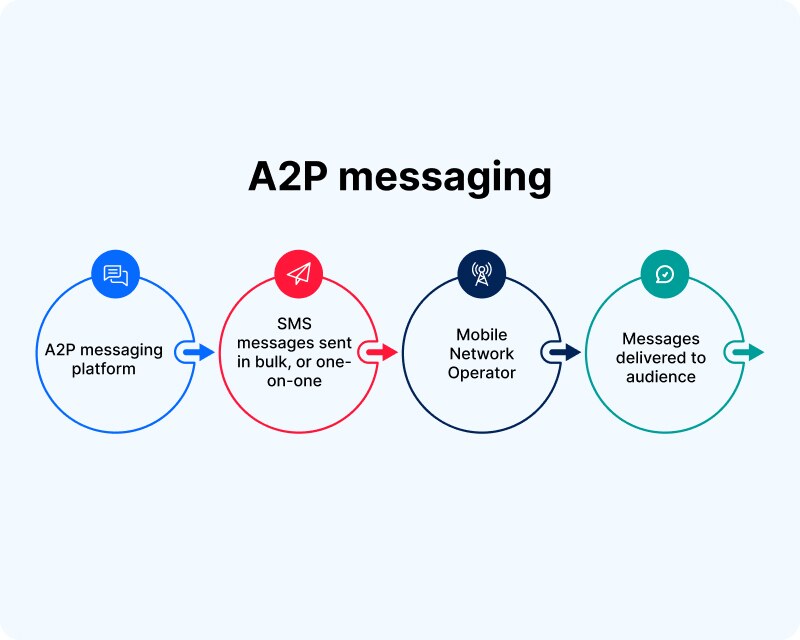
Primarily, there are two ways in which businesses or organizations can send A2P SMS to their customers.
Using an A2P Messaging Platform
Suppose a business wants to send a promotional offer to 1000 customers. It uploads the list of customer contact numbers on the SMS platform of the provider and sends messages in large batches. This process requires manual intervention and is ideal for bulk messaging.
Using an SMS API
Businesses can also connect their website or software systems with an API or Application Programming Interface provided by their SMS provider. In this case, the system automatically sends messages whenever required. For example, when a user signs up for an app, the system automatically sends an OTP for login.
Technologies and Protocols Used in A2P Messaging
Now, let’s get into the technical side of Application-to-Person messaging. It relies on a combination of various messaging protocols and technologies to ensure the reliable, scalable, and efficient delivery of SMS messages.
Messaging Protocols Used in A2P Messaging
Let’s talk about the messaging protocols used in A2P messaging. These protocols contribute towards the reliability and real-time delivery of messages by acting as communication bridges between enterprise applications and telecom infrastructure.
Some of the major protocols used are:
1. SMPP
SMPP protocol is enabler of high-speed, high-volume SMS transmission and is therefore widely used in A2P messaging landscape.
2. HTTP/ HTTPS APIs
These APIs enable developers to integrate SMS capabilities into their systems and are commonly used in web-based applications and SaaS platforms.
3. SS7/ SIGTRAN
SS7 is the traditional protocol set used for SMS routing between operators and delivering messages to subscribers. SIGTRAN is the newer protocol suite that allows SS7 signaling messages to be transported over IP networks.
4. SIP
SIP is typically used for initiating and managing voice or multimedia sessions over IP.
Network and Routing Technologies
1. Intelligent Routing Algorithm
Advanced routing algorithms play a significant role in A2P SMS delivery by selecting the most optimal route to deliver a message based on real-time conditions like network availability, cost-effectiveness, latency, etc.
2. Load Balancing
It helps distribute the SMS traffic evenly across multiple servers, thus preventing congestion during peak-times.
Security and Compliance Measures
1. TLS/ SSL Encryption
The encryption protocols TLS (Transport Layer Security) and SSL (Secure Sockets Layer) are responsible for securing data when transmitting between the SMS platform and the telecom networks.
2. Factor Authentication
OTPs or One time passwords are the most common way to implement 2FA to verify the identity of users. For instance, when logging into a banking app, the system may send an OTP to the user’s mobile number by sending it through an A2P SMS to verify their identity.
3. Anti-Spam Filtering
This involves identifying and blocking unsolicited, irrelevant, or potentially harmful messages from reaching users. A2P platforms implement anti-spam filters that prevent mass spamming, phishing attempts, or messages with prohibited content. Thus protecting user experience and the sender’s reputation i.e. the business.
Benefits of A2P Messaging
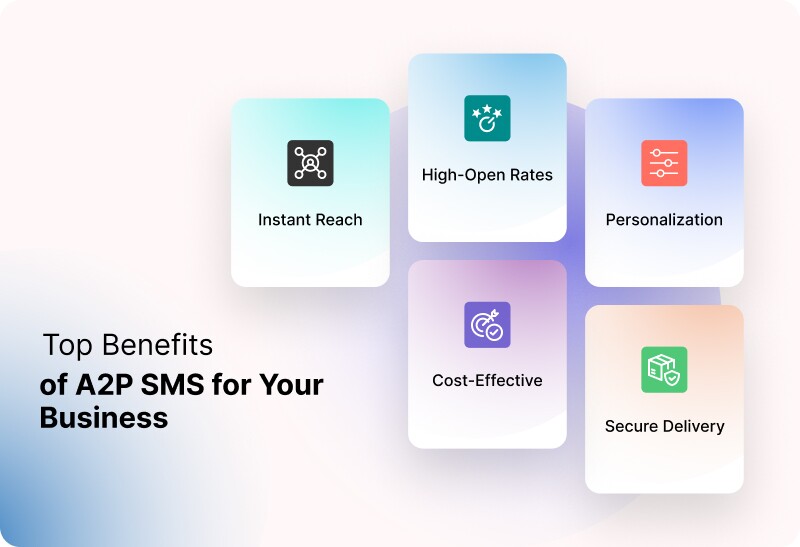
Imagine a scenario where a business communicates with customers via traditional messaging, i.e., P2P. What would it be like? For every order confirmation, delivery update, and other such notifications, the business manually types a confirmation SMS to the customers.
Clearly, employees would spend hours manually typing and sending messages. And, it’s not only time-consuming but:
- Prone to mistakes like typos, wrong recipients, and missed messages
- Extremely difficult for bulk messaging
- no way to schedule messages, track delivery, or customize content
With A2P Messaging in Place
A2P messaging addresses all the above issues and offers much more, making it better. I’m listing down the top advantages of A2P SMS supported by real facts and statistics.
1. Instant Reach with Unmatched Open Rates
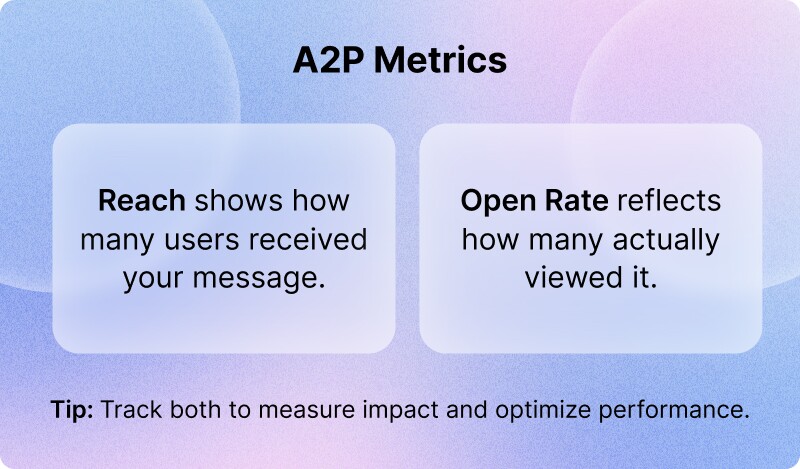
Research shows that SMS messages boast an impressive 98% open rate, making them nearly five times more effective than email. Additionally, 90% of recipients open a text within just three minutes. Furthermore, studies reveal that SMS campaigns see a 45% response rate, compared to only 6% for email. These stats certainly suggest that SMS is a powerful tool for urgent communications, marketing promotions, and customer communication.
2. Secure Message Transmission
SMS messages are encrypted during transmission, minimizing the risk of interception. In industries like finance, e-commerce, and healthcare, where secure communication is critical, SMS ensures that sensitive messages reach the recipients safely. Also, the use of 2FA for OTP-based authentication provides significant protection for user data.
3. Cost-Efficient & Designed for Scale
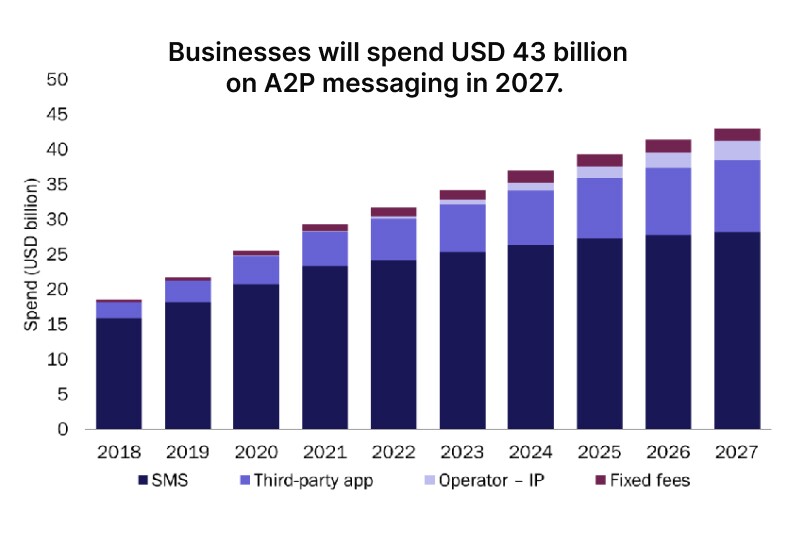
In terms of cost, SMS is an affordable communication solution for businesses looking to scale their outreach. Compared to other marketing channels, SMS is a budget-friendly option, with an average cost of $0.01 to $0.05 per message. Considering the conversion rates for SMS campaigns, which is around 29%, it comes out to be a high-return channel. When it comes to scalability, SMS can handle bulk or mass communication effortlessly. This makes it an ideal communication tool to send hundreds and thousands of messages per second.
4. Data-Safe & Regulation-Ready Messaging
The foundation of A2P messaging platforms is built with data privacy and compliance in mind. Therefore, these platforms help businesses in ensuring that their SMS campaigns align with regulations like GDPR, TCPA and DND policies.
5. Optimized Messaging Workflows with Automation
A2P messaging platforms support automation via APIs, triggers and workflow builders. This redcuces a lot of manual effort and results in boosting conversion without much human effort.
Top 5 A2P Messaging Use Cases
A2P messaging plays a vital role in streamlining communication across industries. Here are five powerful ways businesses are using it today.
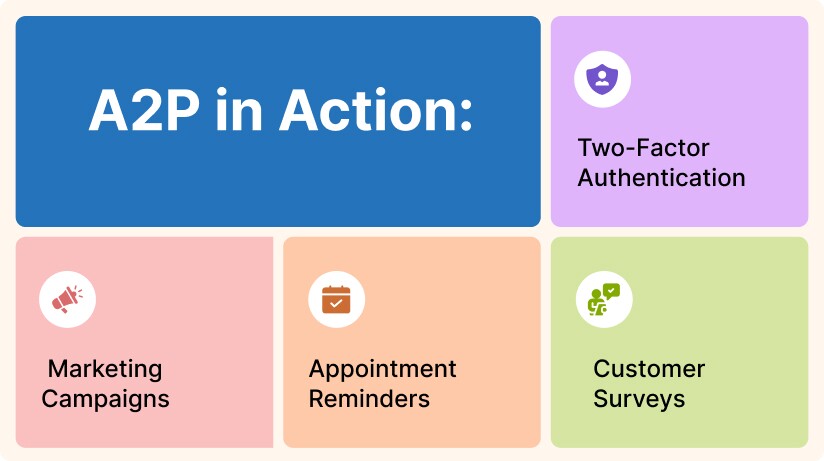
1. Strengthens Security with 2 Factor Authentication
A2P messaging plays a crucial role in protecting user accounts by sending OTPs or authentication codes to registered phone numbers via SMS. For example, when a user logs in to his social media account, the platform sends a verification code to authenticate the user.
2. Improves Marketing and Promotion Effectiveness
A2P messaging is a powerful tool for businesses to send targeted marketing campaigns instantly. The high open rate and fast delivery of SMS help businesses generate instant customer engagement.
3. Effective Management of Appointments and Reminders
Businesses leverage A2P messaging to ensure that customers never miss important updates by sending automated reminders. For example, a clinic sends doctor appointment reminders to patients.
4. Easy Customer Surveys and Feedback Collection
The high open and response rate of SMS makes it a perfect choice for collecting quick insights from customers in the form of their feedback. This helps businesses in understanding the customer satisfaction levels and gather their suggestions to imrove their services.
5. Instant Broadcast of Critical Emergency Alerts
Government agencies need a reliable and instant communication channel to broadcast emergency alerts and notifications. SMS is indeal for sending such time-sensitive messages to large user bases and even in low-connectivity areas.
Choosing the Right A2P Messaging Platform
Now, let’s get to what this blog is really about – How SMS aggregators can choose the right A2P messaging platform to ensure seamless, secure, and efficient message delivery. There are several crucial factors one must understand before proceeding to choose the best SMS platform. Here are the points:

1. Dependable Service with Scalable Capacity
When it comes to A2P messaging, it is crucial to choose a platform that offers consistent and high-quality performance. Also, the platform should be scalable to handle your growing SMS traffic needs without any impact on performance.
2. Detailed Reports & Performance Insights
An SMS platform that offers detailed SMS reports, tracking abilities, advanced alert management, and financial analysis will help you in refining your strategies to keep your aggregator business running optimally.
3. Easy-to-Integrate APIs with Expert Support
For smooth automation, your existing business systems, such as CRMs, need to connect seamlessly with the A2P messaging service. This is where easy-to-integrate APIs will play a crucial role. Alongside, you’ll need technical support from your vendor for smooth onboarding, quick troubleshooting and support whenever any challenge arise.
4. Full-Scale Features, Minimal Learning Curve
The SMS platform will be the foundation of your business; therefore, an advanced, feature-rich A2P messaging platform is a must to run a successful SMS Aggregator business. Before you choose a platform, remember that the market is full of high competition, and it will be difficult for you to survive with a solution that only offers a few features.
A wise step is to look for an SMS platform with a robust routing mechanism, integrated billing and invoicing, multi-protocol support, pricing and rate management, filtering options, etc. Last but not least, opt for a platform with a user-friendly interface so that users have a minimal learning curve.
5. Premium Customer Support and SLAs
Having access to prompt and dependable support simply means your issues will be addressed well in time. Therefore, it is important to check whether the provider offers 24/7 support services across various communication channels, including email, phone, live chat, etc. Also, make sure to check the Service Level Agreements or SLAs to confirm the uptime guarantee and response times.
6. Customer Reviews and Market Reputation
Customer reviews are the true reflection of a business’s reality, revealing the trust and satisfaction it has earned from those who matter most, right? When selecting the right A2P messaging provider, research and read customer reviews and testimonials. You can check those reviews to assess the quality of customer support, user experience, and reliability offered by the provider.
Last, But Not Least!
In the coming time, businesses will continue to prioritize real-time customer engagement, so understanding how A2P works and the significance of choosing the right A2P SMS platform will remain crucial.
REVE SMS platform brings together intelligent automation, advanced routing and analytics to help businesses build stronger, faster and more secure communication channels. Our platform comes with built-in compliance features and the ability to scale effortlessly. At REVE we ensure that your messaging operations are always efficient and future-ready. So if you are looking for an SMS platform with solid performance, precision and ease-of-use, take the free demo and see for yourself.
Frequently Asked Questions
How can SMS aggregators monetize A2P messaging?
SMS aggregators can monetize A2P messaging by charging based on per-message sent and for high-volume messaging. They can also charge premium fees for advanced features such as analytics, security, API integrations, and two-way messaging.
Does A2P messaging help with fraud prevention?
Absolutely yes. A2P messaging can effectively prevent fraud by enabling secure, real-time authentication methods, including OTPs, fraud alerts, 2FA, and transaction confirmations.
What is the cost of A2P messaging?
There are various factors or metrics that determine the cost of A2P messaging, including the country and telecom provider, quantity or volume of messages, type of messages, and the fee charged by aggregators. On average, the cost of A2P messages ranges anywhere between $0.01 to $0.10 per message. However, this is subject to the market and service level.
Will A2P messaging replace email and other emerging communication channels?
While SMS remains a universal communication channel, it is unlikely to fully replace email or other communication channels. Due to its high open rates and ability to work without an internet connection, A2P SMS is ideal for urgent/ important communications. On the other hand, for long-form content and professional communication, email is more suitable.
How secure is A2P messaging?
Like every other technology, vulnerabilities exist in the A2P messaging landscape. However, the integration of advanced security measures, including encryption, security protocols, authentication mechanisms, and fraud detection tools, makes A2P messaging a secure communication channel.




























